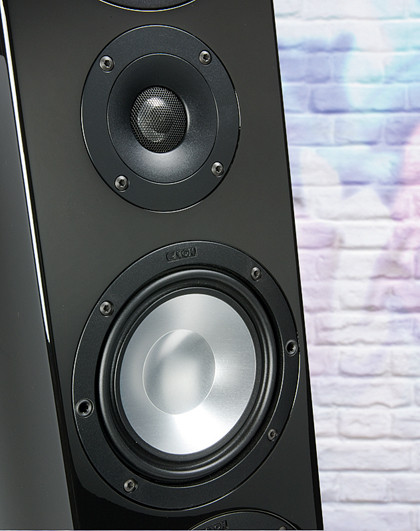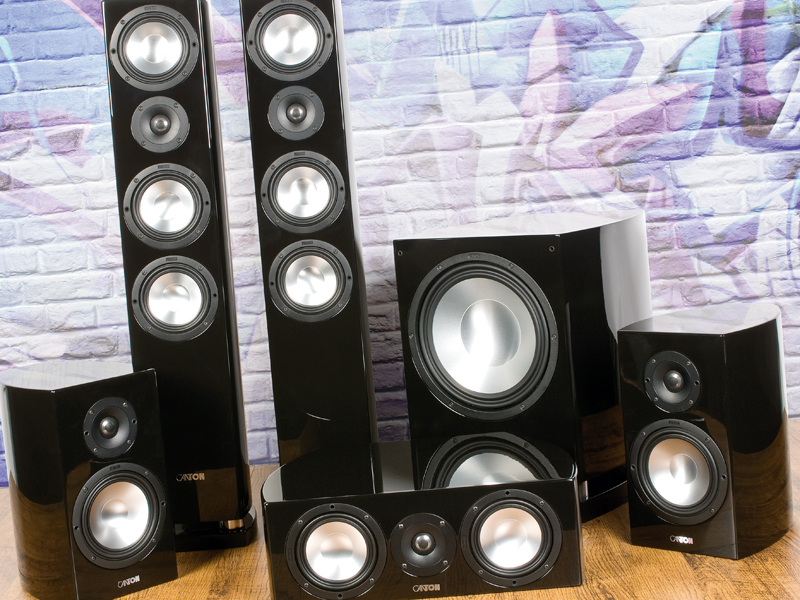TechRadar Verdict
Pros
- +
Fab definition
- +
Fidelity
- +
Sense of real scale
Cons
- -
Piano black marks easily
Why you can trust TechRadar
German loudspeaker brand Canton was one heck of a startup, having hit the deck running back in 1972, with 35 folks all busily making what they knew to be terribly posh speakers. Meanwhile, Acoustic Energy, as I recall, started with just three blokes.
Canton has been doing all sorts ever since, and now offers a fabulous array of loudspeaker types including ground-breaking wireless speakers, THX-certified product and a small selection of premium automotive.
These Vento 800 series speakers are, for me, all about their pinnacle of performance for the money. This array isn't a deeply cost-restricted product that has to make compromises to look good. Instead it's one notch down from the best high-end performers.
Just as B&W makes those insanely costly and iconically gorgeous snaily things (You mean 'Nautilus'– Ed.) and then puts the technology on its more 'normal' speakers, Canton has a majestically costly range called the Reference series.
The Vento 800 is the next range down. It means they get a lot of technology from above and yet didn't have to 'pay' for it.
For this review, we've assembled a 5.1 setup; a set of towers called Vento 880DC, a set of bookshelf speakers called Vento 820, (there's a smaller 810 in the range as well) a Vento 856 centre speaker and an exotic subwoofer called SUB 850R. The combined cost is a little over £6,500.
All are finished in piano black and look immaculate, with subtle badging on them. The solid-framed grilles stay put by dint of small chromed legs that fit into holes in the drivers themselves. So when they are removed, there are no ugly holes to 'scar' the front of the cabinets.
Sign up for breaking news, reviews, opinion, top tech deals, and more.
At this price, you might expect a Neodymium hidden-magnet and steel insert system to simply hold the grilles in place. But Canton grilles are weighty items so it would mean a way bigger redesign than just sinking little bits of Neodymium inside the front baffles.

Gothic appeal
The big 880 DC towers sport an array of metal-coned drivers and a hard-domed tweeter. The latter could be used for calling bats, as Canton claims it reaches way up to twice the recognised limit of human hearing at 40kHz. That's not a waste, though, as boffins reckon we perceive and use these super sonic tones without even realising it and, furthermore, a tweeter that can go that high is really like a trotting racehorse – unstressed and looking frisky.
The whole tower is held an inch or so up in the air on stubby legs above a plinth and the underside of the enclosure has a gas-flowed port mouth. This boundary-loads the port output and raises the power handling of the whole enclosure.
Six-inch cones are used, one as a midbass and two more, fed only bass from the internal passive crossovers. These have dual sets of binding posts from a high-end maker of terminals called DC Technology. You may also have heard of WBT, which the likes of Bowers & Wilkins brag about using… similar concept. Good sockets mean better power transference and detail.
The surround and centre speakers have one of these sets of binding posts on the back and are both ported. The 820s are simple two-ways, with one of the tweeters working with a bigger, 7-inch metal driver, while the centre has two 6-inch drivers (one bass, one midbass) to do a two-way thing with its own bat-tweeter. As they appear to share a common cubic within the enclosure and two ports. This is termed 'two-and-a-half-way'.
The subwoofer is pure sex on a bass line – gorgeous to look at, awesomely clever and well designed. It has sufficient grunt to create real structure-borne building shake, all with a grip of velvety implacability. It doesn't woofle and phlump, but hangs on like a pit-bull terrier to huge throbs, and tracks musical use of the low register like a trouper.
And so it should, as it has a 750W of efficient amplification driving a behemothic and truly handsome 12-inch driver, a seriously long-throw and utterly inflexible piston.

Again, the box is held off its own integral plinth, yet this time, instead of a port underneath like the 880DCs, my probing digit found a very big hexacone, flat diaphragm, passive bass radiator. Like a wobbly flat-cone speaker without a magnet on it, the suspension of this cone, along with the output being acoustically loaded against the bottom plinth, gives the subwoofer the benefits of both ported boxes – for the sheer level – and sealed boxes, while the drive unit is allowed to excurt all the way down to the lowest frequencies the suspensions can allow.
All of which means that when the heroes arrive for their rendezvous with the really big robots in Terminator Salvation, (the bit that starts with the old lady being grabbed through the roof by the big bot's arm), your jaw will hit the floor.
But this array isn't all about bass, and the groaning, throbbing and pulsating low-frequencies of the huge machine doesn't drown out the voices crying in terror in all directions. The centre channel is articulate. There are lots of metallic clangs and Foley effects in the Terminator franchise and this Canton system delivered the lot and in great style.
It offered real impact and visceral excitement, caused by the low power compression in these cones. They have snap and attack, yet without the harshness that some metal-domed tweeters seem to present. These HF devices are that rarity of a delicate and sweet hard dome; they do exist!
Class act

I enjoyed multichannel tunes as well from the dts/DVD-A discs I have, since the grip and placement made for a lovely experience. I did feel that I could have enjoyed them even more if I had about £20,000 worth of amplification, as against my separate Acurus ACT5 paired with a Pioneer LX series AVR.
The Ventos are efficient, but I can tell they have the sort of class that could happily use some serious backup. Canton's Vento series is beautiful to look at and dripping with clever little bits of technology. And I haven't even expounded at length yet about the 13-button subwoofer remote and how you can use it to adjust both phase and crossover points, while selecting fi ed room-EQ settings.
Desirable, with fabulous sound quality and lots of scale and might, they will reward you for upgrading your power amps. I can feel five stars coming on…
Follow TechRadar Reviews on Twitter: http://twitter.com/techradarreview
